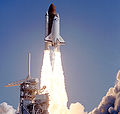
TDRS-4
Encyclopedia
TDRS-4, known before launch as TDRS-D, is an American
communications satellite
which is operated by NASA
as part of the Tracking and Data Relay Satellite System
. It was constructed by TRW
, based on a custom satellite bus
which was used for all seven first generation TDRS satellites.
 TDRS-D was launched aboard during the STS-29R
TDRS-D was launched aboard during the STS-29R
mission in 1989. Discovery launched from Launch Complex 39B
at the Kennedy Space Center
at 14:57:00 GMT on 13 March 1989. TDRS-D was deployed from Discovery a few hours after launch, and was raised to geostationary orbit
by means of an Inertial Upper Stage
.
The twin-stage solid-propellent Inertial Upper Stage made two burns. The first stage burn occurred shortly after deployment from Discovery, and placed the satellite into a geosynchronous transfer orbit. At 03:30 GMT on 14 March, it reached apogee, and the second stage fired, placing TDRS-D into geosynchronous orbit. At this point it received its operational designation, TDRS-4. It was placed at a longitude
41 degrees west of the Greenwich Meridian, from where it provided communications services to spacecraft in Earth orbit, including the Space Shuttle
and International Space Station
. In 2005, it was relocated to 46° West.
United States
The United States of America is a federal constitutional republic comprising fifty states and a federal district...
communications satellite
Communications satellite
A communications satellite is an artificial satellite stationed in space for the purpose of telecommunications...
which is operated by NASA
NASA
The National Aeronautics and Space Administration is the agency of the United States government that is responsible for the nation's civilian space program and for aeronautics and aerospace research...
as part of the Tracking and Data Relay Satellite System
Tracking and Data Relay Satellite System
The Tracking and Data Relay Satellite System is a network of American communications satellites and ground stations used by NASA for space communications. The system was designed to replace an existing network of ground stations that had supported all of NASA's manned flight missions...
. It was constructed by TRW
TRW
TRW Inc. was an American corporation involved in a variety of businesses, mainly aerospace, automotive, and credit reporting. It was a pioneer in multiple fields including electronic components, integrated circuits, computers, software and systems engineering. TRW built many spacecraft,...
, based on a custom satellite bus
Satellite bus
A satellite bus or spacecraft bus is the general model on which multiple-production satellite spacecraft are often based. The bus is the infrastructure of a spacecraft, usually providing locations for the payload .They are most commonly used for geosynchronous satellites, particularly...
which was used for all seven first generation TDRS satellites.

STS-29
-Mission parameters:*Mass:**Orbiter liftoff: **Orbiter landing: **Payload: *Perigee: *Apogee: *Inclination: 28.5°*Period: 90.6 min-Mission summary:Space Shuttle Discovery lifted off from Pad B, Launch...
mission in 1989. Discovery launched from Launch Complex 39B
Kennedy Space Center Launch Complex 39
Launch Complex 39 is a rocket launch site at the John F. Kennedy Space Center on Merritt Island in Florida, USA. The site and its collection of facilities were originally built for the Apollo program, and later modified to support Space Shuttle operations. NASA began modifying LC-39 in 2007 to...
at the Kennedy Space Center
Kennedy Space Center
The John F. Kennedy Space Center is the NASA installation that has been the launch site for every United States human space flight since 1968. Although such flights are currently on hiatus, KSC continues to manage and operate unmanned rocket launch facilities for America's civilian space program...
at 14:57:00 GMT on 13 March 1989. TDRS-D was deployed from Discovery a few hours after launch, and was raised to geostationary orbit
Geostationary orbit
A geostationary orbit is a geosynchronous orbit directly above the Earth's equator , with a period equal to the Earth's rotational period and an orbital eccentricity of approximately zero. An object in a geostationary orbit appears motionless, at a fixed position in the sky, to ground observers...
by means of an Inertial Upper Stage
Inertial Upper Stage
The Inertial Upper Stage , originally known as the Interim Upper Stage, is a two-stage solid-fueled booster rocket developed by the U.S...
.
The twin-stage solid-propellent Inertial Upper Stage made two burns. The first stage burn occurred shortly after deployment from Discovery, and placed the satellite into a geosynchronous transfer orbit. At 03:30 GMT on 14 March, it reached apogee, and the second stage fired, placing TDRS-D into geosynchronous orbit. At this point it received its operational designation, TDRS-4. It was placed at a longitude
Longitude
Longitude is a geographic coordinate that specifies the east-west position of a point on the Earth's surface. It is an angular measurement, usually expressed in degrees, minutes and seconds, and denoted by the Greek letter lambda ....
41 degrees west of the Greenwich Meridian, from where it provided communications services to spacecraft in Earth orbit, including the Space Shuttle
Space Shuttle
The Space Shuttle was a manned orbital rocket and spacecraft system operated by NASA on 135 missions from 1981 to 2011. The system combined rocket launch, orbital spacecraft, and re-entry spaceplane with modular add-ons...
and International Space Station
International Space Station
The International Space Station is a habitable, artificial satellite in low Earth orbit. The ISS follows the Salyut, Almaz, Cosmos, Skylab, and Mir space stations, as the 11th space station launched, not including the Genesis I and II prototypes...
. In 2005, it was relocated to 46° West.

